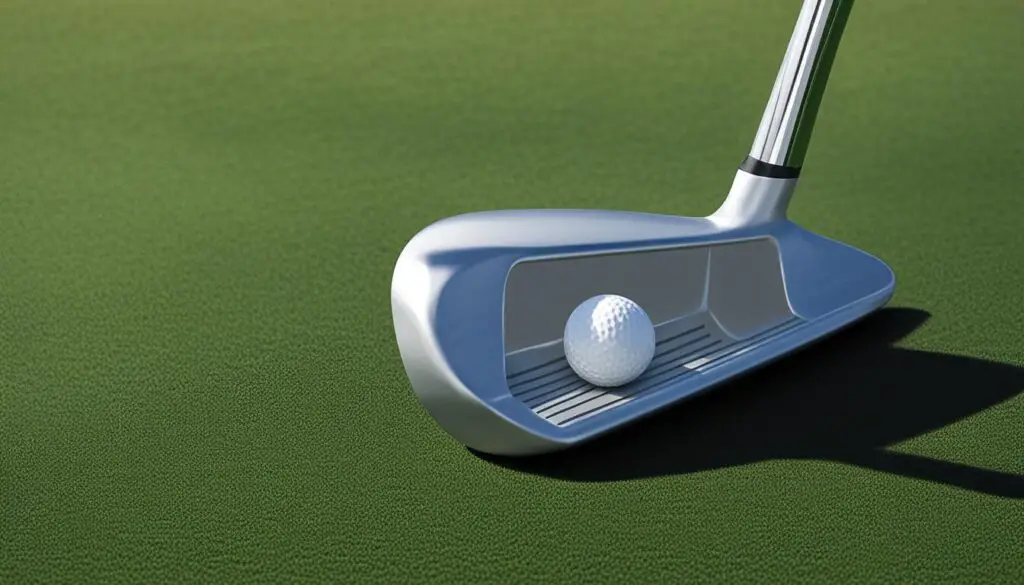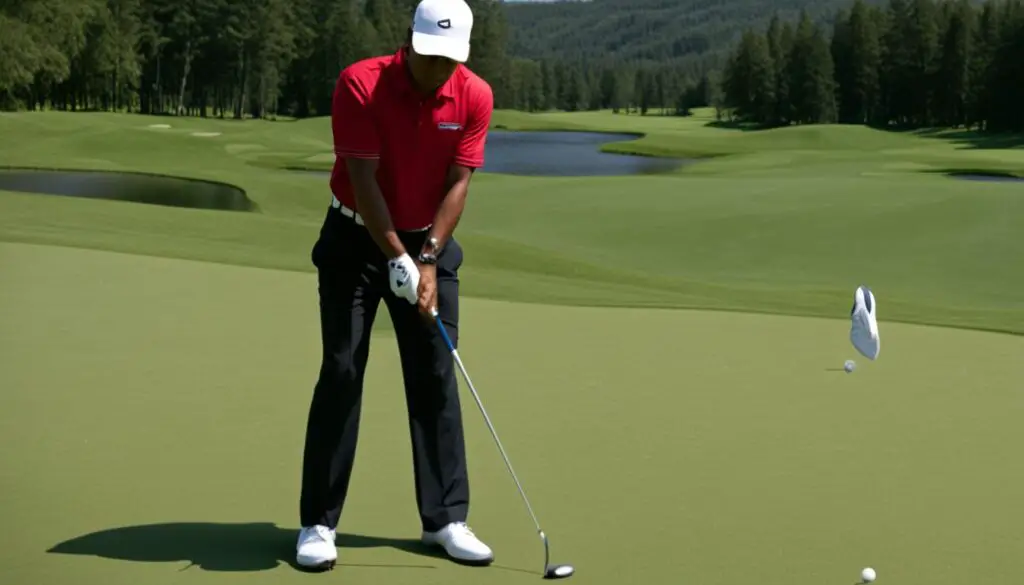Holding a golf club properly is crucial for a successful golf swing. The grip is often considered the most important aspect of the swing, as it sets the foundation for the entire motion. Learning how to hold a golf club will help you improve control and distance with your driver. Let’s dive into the step-by-step guide and different grip options to find the perfect driver grip.
Key Takeaways:
- Proper hand positioning and grip technique are essential for achieving better shots with a golf club driver.
- Your left hand should align the handle with your palm and rest the heel of your palm along the top edge of the handle.
- Position your right hand on top of your left thumb, creating a “V” that points to the middle of your sternum for a neutral grip.
- Experiment with different grip types, such as the overlapping grip, interlocking grip, and 10-finger grip, to find what works best for you.
- Remember to adjust your hand positioning when holding a driver vs a putter, as the two require different grips.
Step-by-Step Guide to Holding a Golf Club
Properly gripping a golf club driver is essential for achieving an optimal swing. The way you hold the club sets the stage for your entire golf motion, affecting control, accuracy, and distance. Follow this step-by-step guide to ensure you have the best grip possible for your driver.
- Start by holding the club waist-high in front of you and square the club face. This ensures the club is properly aligned for your swing.
- Begin with your left hand. Align your palm with the handle and rest the heel of your palm along the top edge of the handle. This positioning helps maintain stability and control.
- Rotate your left hand slightly towards the target so that you can see two knuckles on your left hand. This is known as a neutral grip and is a great starting point for many golfers.
- Now position your right hand on top of your left thumb. This creates a “V” shape that points towards the middle of your sternum.
Remember to maintain a relaxed grip pressure throughout your swing. Holding the club too tightly can hinder your swing and reduce control. Experiment with your grip to find what feels most comfortable and natural for you.
Image:
Types of Golf Grips
There are three basic types of golf grips that golfers can use to hold their driver: the overlapping grip, interlocking grip, and 10-finger grip. Each of these grips offers a unique feel and can impact your swing in different ways. Let’s explore these grip types to help you find the one that works best for you.
Overlapping Grip
The overlapping grip, also known as the Vardon grip, is one of the most popular grips used by golfers. To perform this grip, place the pinkie finger of your trailing hand (right hand for right-handed golfers) between the index and middle fingers of your lead hand. This grip provides stability and control and is often preferred by golfers with larger hands.
Interlocking Grip
The interlocking grip is another widely used grip among golfers, especially those with smaller hands. Start with the 10-finger grip, then interlock the pinkie finger of your trailing hand with the index finger of your lead hand. This grip promotes a unified motion between your hands and can provide added power to your swing.
10-Finger Grip
The 10-finger grip, also known as the baseball grip, is a grip style that involves all ten fingers touching the grip of the club. This grip is often more comfortable for beginners or golfers with smaller hands as it allows for greater control over the club. It can also help golfers who struggle with hand separation during the swing.
When choosing a golf grip, it’s essential to consider your hand size, comfort, and how each grip influences your swing. Experimenting with different grip types will help you determine which one feels most natural and enhances your performance on the course.
Differences in Holding a Driver Vs a Putter
When it comes to holding a golf club, whether it’s a driver or a putter, there are distinct differences in hand positions that can greatly affect your swing and overall game. Understanding the proper grip for each club is essential for achieving optimal performance on the course.
When holding a driver, it’s important to start with a solid foundation. Begin by gripping the club at the base of the handle with your left hand. Ensure that the club rests diagonally across your fingers, with the handle running through the space between your index finger and thumb. This neutral grip allows for flexibility and control during your swing.

Next, overlap your right hand over your left hand on the club. Your right hand should overlap the ring and middle fingers of your left hand, creating a secure grip. Position your right thumb and index finger to form a “V” that aligns with the middle of your torso. This grip allows for a natural and fluid swing motion, maximizing your power and accuracy.
On the other hand, holding a putter requires a slightly different technique. Start by placing the putter up to your outstretched left hand. The handle should run through the center of your hand, with your fingers wrapping around it comfortably. This grip promotes stability and control during your putting stroke.
Just like holding a driver, use the same hand placement for your right hand when holding a putter. Position your right hand below your left hand, mirroring the same grip you have with your left hand. This balanced grip allows for consistent and precise putts on the green.
Remember, finding a grip that feels comfortable and natural to you is key. Experiment with different grip styles and hand positions to discover what works best for your swing and overall game. With practice and consistency, you’ll be able to develop a solid grip for both your driver and putter, enhancing your performance on the golf course.
Left-Handed Vs Right-Handed Golf Clubs
When it comes to playing golf, left-handed and right-handed golfers have opposite hand placements on the golf club. Left-handed golfers, like Adam Scott, have a unique challenge when it comes to finding the correct hand placement and grip technique.
For left-handed golfers, the correct placement of their hands on the club is essential for a successful swing. The right hand should be positioned at the edge of the handle, ensuring a firm and comfortable grip. Conversely, the left hand should be placed closer to the head of the club for maximum control and power.
The opposite hand placement for left-handed golfers applies to both the grip technique and hand positioning. By following this recommended hand placement, left-handed golfers can achieve a solid connection with the club and enhance their overall performance on the golf course.
It’s important to note that although the hand placement differs for left-handed golfers, the overall golf grip technique remains the same regardless of whether you are left-handed or right-handed. It’s all about finding the grip style that suits you best and allows for a consistent and controlled swing.

Image: A left-handed golfer demonstrating the correct hand placement for left-handed golfers.
Conclusion
Holding a golf club driver properly is essential for improving your shots on the golf course. The grip you have on the club is the foundation of a successful swing, affecting your control and distance. By following the step-by-step guide and experimenting with different grip types, you can find the perfect grip that suits your game.
Remember to maintain a relaxed grip pressure, as gripping the club too tightly can hinder your swing. Consistent practice is key to mastering your golf driver grip and ultimately improving your overall game. Take your time to understand the different grip options and find the one that feels most comfortable for you.
So, whether you prefer the overlapping grip, interlocking grip, or the 10-finger grip, explore and find what works best for your swing. As you continue to refine your grip, you’ll notice an improvement in your driver shots. So go out there, play with confidence, and enjoy the game!
FAQ
Why is holding a golf club properly important?
Holding a golf club properly is crucial for a successful golf swing as it sets the foundation for the entire motion and helps improve control and distance with your driver.
How should I hold a golf club driver?
To hold a golf club driver, grab the club with your left hand first, aligning the handle with your palm and resting the heel of your palm along the top edge of the handle. Position your right hand on top of your left thumb, creating a “V” that points to the middle of your sternum.
What are the different types of golf grips?
The different types of golf grips include the overlapping grip, interlocking grip, and 10-finger grip. The overlapping grip involves positioning the pinkie finger of one hand between the other hand’s index and middle finger. The interlocking grip interlocks the pinkie finger of one hand with the other hand’s index finger. The 10-finger grip, also known as the “baseball grip,” involves all ten fingers touching the grip.
How do I hold a driver differently from a putter?
When holding a driver, grip the club at the base of the handle with your left hand and overlap your right hand so it overlaps the ring and middle fingers of your left hand. When holding a putter, place the putter up to your outstretched left hand with the handle running through the center of your hand and use the same hand placement for your right hand below your left hand.
What is the hand placement for left-handed and right-handed golfers?
Left-handed golfers should place their right hand at the edge of the handle and their left hand closer to the head. Right-handed golfers should have their left hand at the edge of the handle and their right hand closer to the head.
How can I improve my driver grip for better shots?
To improve your driver grip for better shots, practice consistently and experiment with different grip types to find the one that works best for you. Remember to maintain a relaxed grip pressure.
